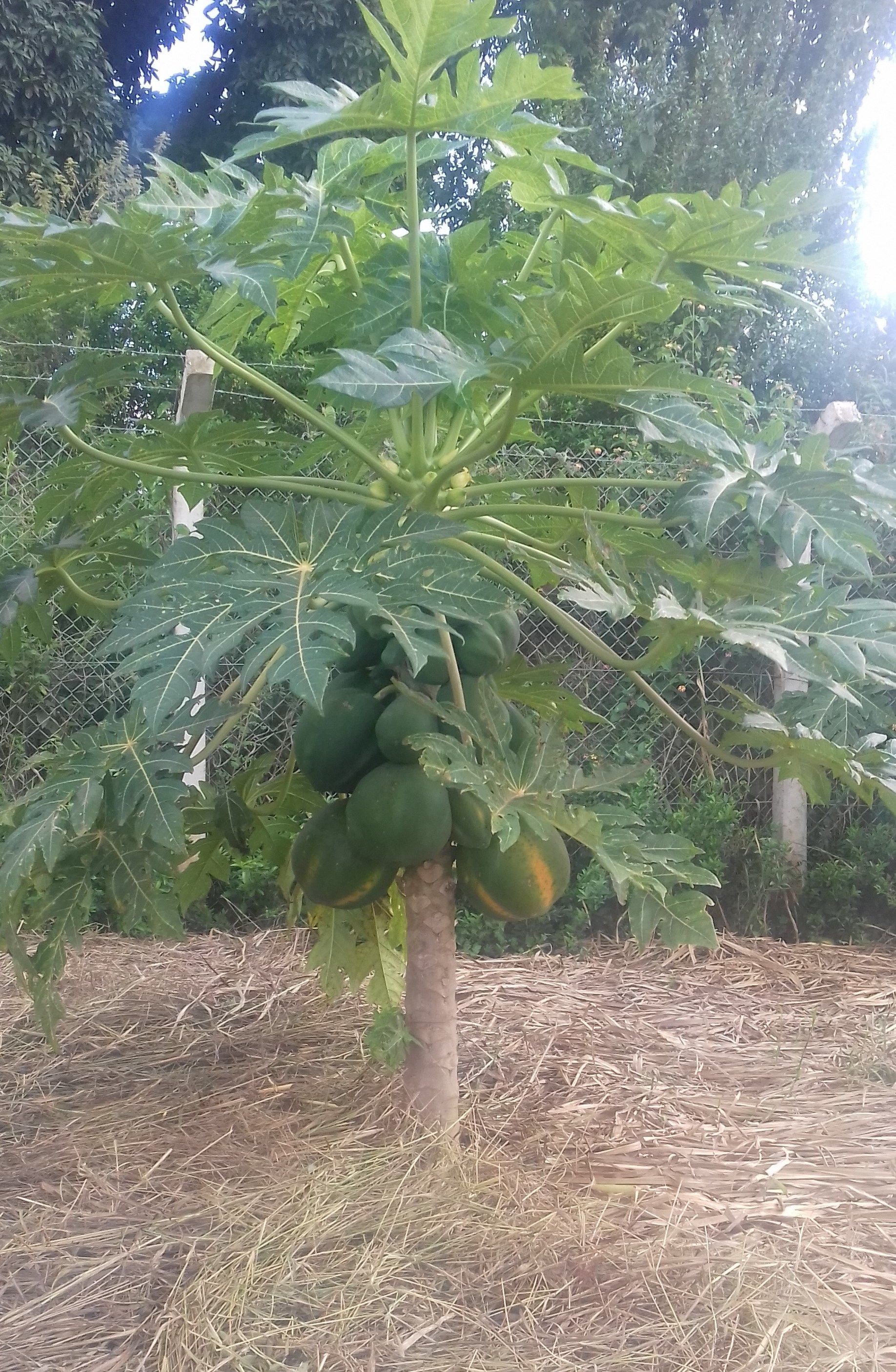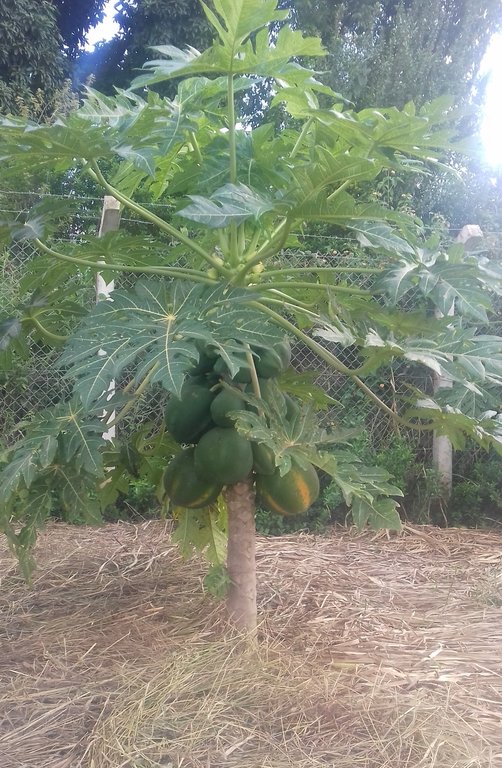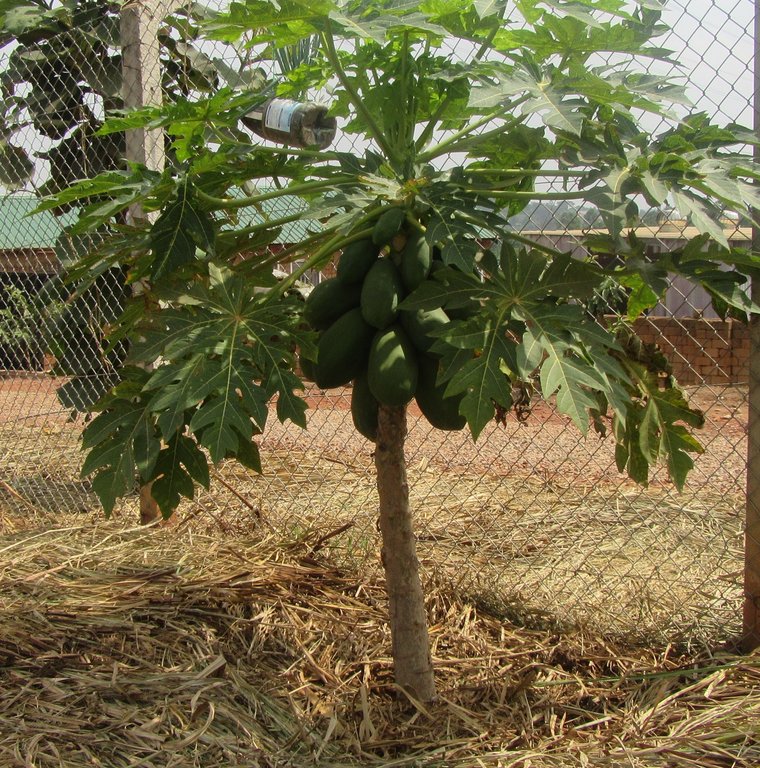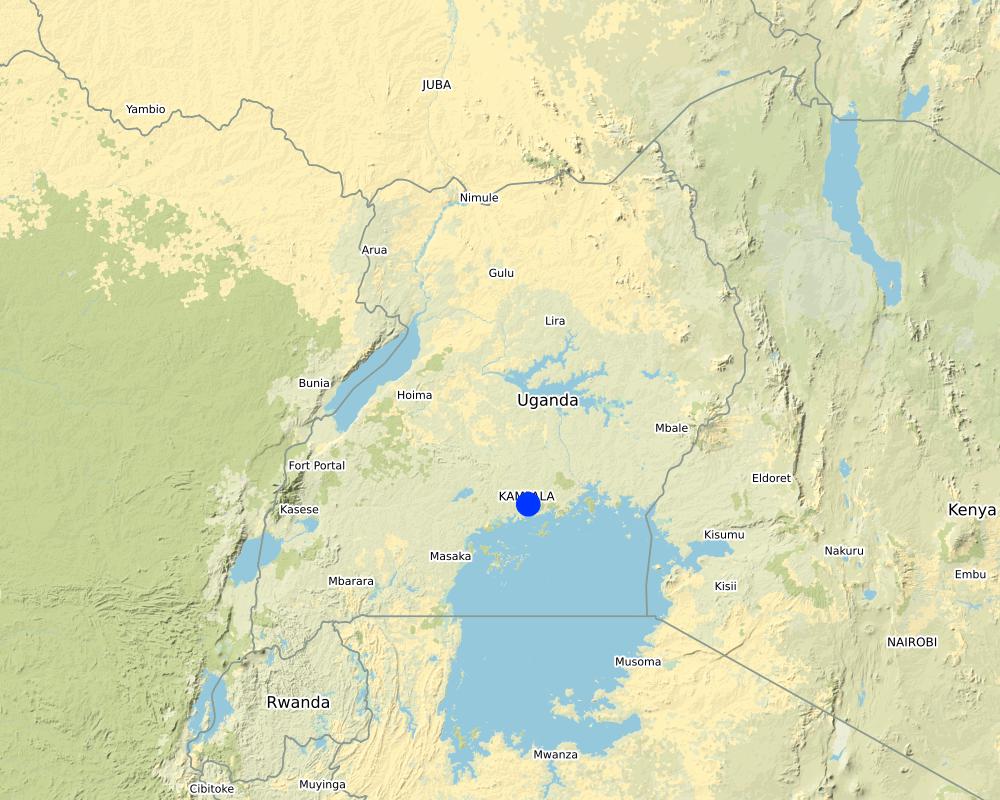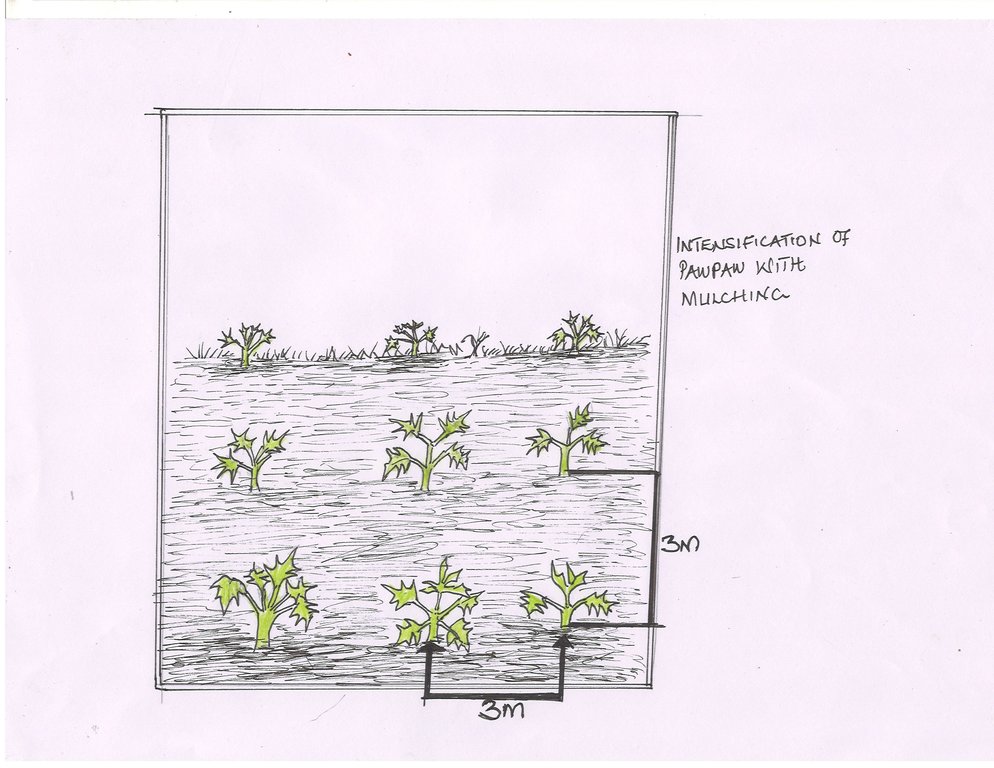Intensification of pawpaw with mulching [Ouganda]
- Création :
- Mise à jour :
- Compilateur : Babirye Irene
- Rédacteur : Kamugisha Rick Nelson
- Examinateurs : Nicole Harari, Udo Höggel, Donia Mühlematter
Okulima amapapali
technologies_3461 - Ouganda
Voir les sections
Développer tout Réduire tout1. Informations générales
1.2 Coordonnées des personnes-ressources et des institutions impliquées dans l'évaluation et la documentation de la Technologie
Personne(s)-ressource(s) clé(s)
exploitant des terres:
Kasasila Medad
+256702776511
NARO
Ttakajjunge Village, Namubiru Parish, Nama Sub-county Mukono District.
Ouganda
Nom du projet qui a facilité la documentation/ l'évaluation de la Technologie (si pertinent)
Scaling-up SLM practices by smallholder farmers (IFAD)Nom du ou des institutions qui ont facilité la documentation/ l'évaluation de la Technologie (si pertinent)
National Agricultural Research Organisation (NARO) - Ouganda1.3 Conditions relatives à l'utilisation par WOCAT des données documentées
Quand les données ont-elles été compilées (sur le terrain)?
01/02/2018
Le compilateur et la(les) personne(s) ressource(s) acceptent les conditions relatives à l'utilisation par WOCAT des données documentées:
Oui
1.4 Déclaration sur la durabilité de la Technologie décrite
Est-ce que la Technologie décrite ici pose problème par rapport à la dégradation des terres, de telle sorte qu'elle ne peut pas être déclarée comme étant une technologie de gestion durable des terres?
Non
2. Description de la Technologie de GDT
2.1 Courte description de la Technologie
Définition de la Technologie:
Improved pawpaw (Carica papaya) fruit tree growing using improved varieties for Sustainable Land Management Practices and income generation.
2.2 Description détaillée de la Technologie
Description:
Intensification of pawpaw with mulching. It is the growing of improved pawpaw fruit tree growing for sustainable land management practices and income generation among small scale and medium farmers in Kampala. This is established on 1.5 acres of land. The technology is mostly prefered because it doesn’t require much attention or specialized planting (labour). The cultivation is pest-resistant, and thrives in well-drained soil with an equal balance of sunshine and shade as well as reduction of soil degradation. Under this technology, pawpaws are integrated with trenches with the aim of reducing soil and water erosion for increased production and soil fertility improvement. In Uganda, specifically Kampala District, the technology started in 2012 where the host farmer visited a friend in the neighbouring village, who was growing pawpaw on a commercial scale, and acquired knowledge and skills, inputs and resources needed for establishment.
To get the pawpaw seeds, I got a ripe pawpaw from which I extracted healthy seeds, which I used to make a nursery bed. The pawpaw seeds I got were of the big pawpaw with yellow flesh. I chose this variety because it has a longer shelf life compared to the red flesh variety. In addition, its fruits are big and tasty. and then I dried them in the sun. Got two Units of loam / sandy soil mixed with one basin of cow dung to improve on its drainage and fertility, filled the bags with a mixture of sandy loam manured soil, sown 1 or 2 seeds in each bag and covered with soil, then watered the beds once every day, morning or evening. (description of farmer)
The farmer also covered the bags with thatch grass to keep them warm and moist still they emerge. After one month when the seedlings had germinated he sprayed them with Vegimax, which is an Organic Supplement for all types of plants that helps improve the quality, yield, appearance as well as soil condition and later applied 'Dudu cyper' (insecticide) to kill insects that attack the leaves. When the seedlings were about 10-15 cm tall, they were transplanted onto a well prepared field. A slit was cut into the plastic bag down one side to remove the bag and place the plant into the planting pit. Spacing of plants was approximately 3 metres between rows and 3 metres between plants. Soil was raked in to cover the roots. The plants were then watered to provide moisture needed for proper rooting and growth.
Activities carried out in this technology include: Nursery bed preparation, watering once a day, garden preparation, digging of planting pits, mixing animal manure with soil, transplanting from the nursery bed to the main garden, mulching the garden using banana leaves and grass, spraying the plantations,pruning and harvesting. Proper spacing of trees is important because if they are not well spaced, they will just grow tall and fruiting will be poor. I started with one acre of pawpaw where I had initially 250 pawpaw trees but a density of up to 440 trees is possible.
The technology is good at income generating. Having one acre of the improved pawpaw the farmer can pick five to seven pawpaws every week from each tree and harvest throughout the year so every time the farmer has something to sell to the market. However Paw paws are easily perishable and this affects the market in addition to being affected by weather changes especially when it rains a lot the demand for the fruit becomes very low and when it’s the long dry spells also affect the plantations since the farmer cannot afford to irrigate through the dry season. During long dry periods, pawpaw doesn’t perform well so the harvest is low. Strong wind can cause problems to pawpaw plantations because pawpaw plants have a shallow root system, they get very top heavy as they grow older, and they blow over easily. Then there are birds and fruit bats which affect the plantation. In case of such scenarios its advisable that the farmer keeps in touch with extension worker for advisory services and all the necessary management advice (pest management, watering and marketing).
2.3 Photos de la Technologie
Remarques générales concernant les photos:
At the moment i cannot have the preparation and management of the technology since by the time I documented it, the farmer was harvesting.
2.4 Vidéos de la Technologie
Commentaire, brève description:
Pawpaw growing with mulching on a small scale.
Date:
01/03/2018
Lieu:
Ttakajjunge village, Namubiru Parish, Nama subcounty, Mukono District.
Nom du vidéaste:
Irene Babirye
2.5 Pays/ région/ lieux où la Technologie a été appliquée et qui sont couverts par cette évaluation
Pays:
Ouganda
Région/ Etat/ Province:
Mukono District, Central Region
Autres spécifications du lieu:
Ttakajjunge village, Namubiru parish, Nama Village Mukono District.
Commentaires:
N00.23372, e032.59098
Map
×2.6 Date de mise en œuvre de la Technologie
Indiquez l'année de mise en œuvre:
2016
Si l'année précise est inconnue, indiquez la date approximative: :
- il y a moins de 10 ans (récemment)
2.7 Introduction de la Technologie
Spécifiez comment la Technologie a été introduite: :
- grâce à l'innovation d'exploitants des terres
- au cours d'expérimentations / de recherches
Commentaires (type de projet, etc.) :
From my neighbor.
3. Classification de la Technologie de GDT
3.1 Principal(aux) objectif(s) de la Technologie
- améliorer la production
- réduire, prévenir, restaurer les terres dégradées
- conserver/ améliorer la biodiversité
- réduire les risques de catastrophes
- créer un impact économique positif
- créer un impact social positif
3.2 Type(s) actuel(s) d'utilisation des terres, là où la Technologie est appliquée

Terres cultivées
- Cultures pérennes (non ligneuses)
Principales cultures (vivrières et commerciales):
pawpaw

Forêts/ bois
Plantations d'arbres, boisements:
- Variété exotique en monoculture
Produits et services:
- Fruits et noix
3.3 Informations complémentaires sur l'utilisation des terres
Approvisionnement en eau des terres sur lesquelles est appliquée la Technologie:
- pluvial
Nombre de période de croissance par an: :
- 2
Précisez:
Main harvest in May and December.
3.4 Groupe de GDT auquel appartient la Technologie
- Amélioration de la couverture végétale/ du sol
- perturbation minimale du sol
- gestion intégrée de la fertilité des sols
3.5 Diffusion de la Technologie
Spécifiez la diffusion de la Technologie:
- répartie uniformément sur une zone
Si la Technologie est uniformément répartie sur une zone, indiquez la superficie couverte approximative:
- < 0,1 km2 (10 ha)
Commentaires:
The technology is applied on a 1.5 acre plot
3.6 Mesures de GDT constituant la Technologie

pratiques agronomiques
- A1: Couverture végétale/ du sol
- A2: Matière organique/ fertilité du sol
- A5: Gestion des semences, amélioration des variétés

pratiques végétales
- V2: Herbes et plantes herbacées pérennes

structures physiques
- S1: Terrasses

modes de gestion
- M4: Changement majeur dans le calendrier des activités
3.7 Principaux types de dégradation des terres traités par la Technologie

érosion éolienne des sols

dégradation biologique
- Bl: perte de la vie des sols
Commentaires:
This technology is not done primarily to reduce land degradation. This is rather a side effect.
3.8 Prévention, réduction de la dégradation ou réhabilitation des terres dégradées
Spécifiez l'objectif de la Technologie au regard de la dégradation des terres:
- non applicable
Commentaires:
This technology is not done primarily to reduce land degradation. This is rather a side effect.
4. Spécifications techniques, activités, intrants et coûts de mise en œuvre
4.1 Dessin technique de la Technologie
4.2 Spécification/ explications techniques du dessin technique
The technical drawing shows pawpaw trees planted at a spacing of 3 m x 3 m from one pawpaw to another pawpaw tree. The planting hole is 30 cm deep.
Slope: Gentle sloping
4.3 Informations générales sur le calcul des intrants et des coûts
Spécifiez la manière dont les coûts et les intrants ont été calculés:
- par superficie de la Technologie
Indiquez la taille et l'unité de surface:
1.5 acre
Indiquez la monnaie utilisée pour le calcul des coûts:
- dollars US
Indiquer le taux de change du dollars en monnaie locale (si pertinent): 1 USD= :
3600,0
Indiquez le coût salarial moyen de la main d'œuvre par jour:
2.8
4.4 Activités de mise en place/ d'établissement
| Activité | Type de mesures | Calendrier | |
|---|---|---|---|
| 1. | Nursery Preparation | Agronomique | 2 days |
| 2. | Watering | Modes de gestion | everyday |
| 3. | Garden preparation | Agronomique | 7 days |
| 4. | Digging pits | Agronomique | 4 days |
| 5. | Compost and soil mixing | Agronomique | 2 days |
| 6. | Transplanting | Agronomique | 5 days |
| 7. | Mulching | Agronomique | 2 days |
| 8. | Spraying | Agronomique | 1 day |
4.5 Coûts et intrants nécessaires à la mise en place
| Spécifiez les intrants | Unité | Quantité | Coûts par unité | Coût total par intrant | % du coût supporté par les exploitants des terres | |
|---|---|---|---|---|---|---|
| Main d'œuvre | Nursery Preparation | Man days | 2,0 | 2,8 | 5,6 | 100,0 |
| Main d'œuvre | Watering | Man days | 1,0 | 1,39 | 1,39 | 100,0 |
| Main d'œuvre | Garden preparation | Man days | 4,0 | 2,8 | 11,2 | 100,0 |
| Main d'œuvre | Digging pits | Man days | 4,0 | 2,8 | 11,2 | 100,0 |
| Equipements | Animal manure and soil mixing | Man days | 2,0 | 1,39 | 2,78 | 100,0 |
| Equipements | Transplanting | Man days | 5,0 | 2,8 | 14,0 | 100,0 |
| Equipements | Mulching the garden | Man days | 5,0 | 2,8 | 14,0 | 100,0 |
| Equipements | Spraying | Man days | 1,0 | 2,8 | 2,8 | 100,0 |
| Equipements | Hoes | Pieces | 5,0 | 2,8 | 14,0 | 100,0 |
| Equipements | Wheelbarrows | Pieces | 3,0 | 33,4 | 100,2 | 100,0 |
| Equipements | Gumboots | Pairs | 5,0 | 3,4 | 17,0 | 100,0 |
| Equipements | Sprayer pump | Piece | 1,0 | 13,9 | 13,9 | 100,0 |
| Matériel végétal | Watering cans | Pieces | 3,0 | 2,8 | 8,4 | 100,0 |
| Matériel végétal | Seeds | Kilograms | 5,0 | 1,39 | 6,95 | 100,0 |
| Engrais et biocides | Vegimax, | Litres | 5,0 | 3,4 | 17,0 | 100,0 |
| Engrais et biocides | Dudu cyper | Litres | 3,0 | 2,8 | 8,4 | 100,0 |
| Engrais et biocides | Dythene | Kilograms | 3,0 | 6,94 | 20,82 | 100,0 |
| Engrais et biocides | Animal manure | Trip | 1,0 | 11,2 | 11,2 | 100,0 |
| Coût total de mise en place de la Technologie | 280,84 | |||||
Commentaires:
The land user had ready capital to establish the technology.
4.6 Activités d'entretien/ récurrentes
| Activité | Type de mesures | Calendrier/ fréquence | |
|---|---|---|---|
| 1. | Spraying | Agronomique | Every after 3 weeks |
| 2. | Prunning | Agronomique | Every week |
| 3. | Digging | Agronomique | Every month |
| 4. | Mulching | Agronomique | Every after 6 months |
| 5. | Animal manure application to the garden | Agronomique | Every after a year |
4.7 Coûts et intrants nécessaires aux activités d'entretien/ récurrentes (par an)
| Spécifiez les intrants | Unité | Quantité | Coûts par unité | Coût total par intrant | % du coût supporté par les exploitants des terres | |
|---|---|---|---|---|---|---|
| Main d'œuvre | Spraying | Man day | 1,0 | 2,8 | 2,8 | 100,0 |
| Main d'œuvre | Prunning | Man day | 2,0 | 2,8 | 5,6 | 100,0 |
| Main d'œuvre | Mulching | Man day | 3,0 | 2,8 | 8,4 | 100,0 |
| Main d'œuvre | Animal manure application to the garden | Man day | 2,0 | 2,8 | 5,6 | 100,0 |
| Equipements | Harvesting | Man day | 2,0 | 2,8 | 5,6 | 100,0 |
| Equipements | Hoes | Pieces | 5,0 | 2,8 | 14,0 | 100,0 |
| Equipements | Sprayer pump | Piece | 1,0 | 2,8 | 2,8 | 100,0 |
| Equipements | 1,0 | 13,9 | 13,9 | 100,0 | ||
| Engrais et biocides | Vegimax | Litres | 5,0 | 3,4 | 17,0 | 100,0 |
| Engrais et biocides | Dudu cyper | Litres | 3,0 | 2,8 | 8,4 | 100,0 |
| Engrais et biocides | Dythene | Litres | 5,0 | 6,94 | 34,7 | 100,0 |
| Engrais et biocides | Animal manure | Trip | 1,0 | 11,2 | 11,2 | 100,0 |
| Coût total d'entretien de la Technologie | 130,0 | |||||
Commentaires:
The land user incurs all the costs.
4.8 Facteurs les plus importants affectant les coûts
Décrivez les facteurs les plus importants affectant les coûts :
Labor costs are those cost which most heavily affect the technology.
5. Environnement naturel et humain
5.1 Climat
Précipitations annuelles
- < 250 mm
- 251-500 mm
- 501-750 mm
- 751-1000 mm
- 1001-1500 mm
- 1501-2000 mm
- 2001-3000 mm
- 3001-4000 mm
- > 4000 mm
Spécifiez la pluviométrie moyenne annuelle (si connue), en mm:
1500,00
Zone agro-climatique
- humide
5.2 Topographie
Pentes moyennes:
- plat (0-2 %)
- faible (3-5%)
- modéré (6-10%)
- onduleux (11-15%)
- vallonné (16-30%)
- raide (31-60%)
- très raide (>60%)
Reliefs:
- plateaux/ plaines
- crêtes
- flancs/ pentes de montagne
- flancs/ pentes de colline
- piémonts/ glacis (bas de pente)
- fonds de vallée/bas-fonds
Zones altitudinales:
- 0-100 m
- 101-500 m
- 501-1000 m
- 1001-1500 m
- 1501-2000 m
- 2001-2500 m
- 2501-3000 m
- 3001-4000 m
- > 4000 m
Indiquez si la Technologie est spécifiquement appliquée dans des:
- non pertinent
5.3 Sols
Profondeur moyenne du sol:
- très superficiel (0-20 cm)
- superficiel (21-50 cm)
- modérément profond (51-80 cm)
- profond (81-120 cm)
- très profond (>120 cm)
Texture du sol (de la couche arable):
- moyen (limoneux)
Texture du sol (> 20 cm sous la surface):
- moyen (limoneux)
Matière organique de la couche arable:
- moyen (1-3%)
5.4 Disponibilité et qualité de l'eau
Profondeur estimée de l’eau dans le sol:
5-50 m
Disponibilité de l’eau de surface:
bonne
Qualité de l’eau (non traitée):
eau potable
La salinité de l'eau est-elle un problème? :
Non
La zone est-elle inondée?
Non
5.5 Biodiversité
Diversité des espèces:
- faible
Diversité des habitats:
- faible
5.6 Caractéristiques des exploitants des terres appliquant la Technologie
Sédentaire ou nomade:
- Sédentaire
Orientation du système de production:
- mixte (de subsistance/ commercial)
- commercial/ de marché
Revenus hors exploitation:
- moins de 10% de tous les revenus
Niveau relatif de richesse:
- moyen
Individus ou groupes:
- individu/ ménage
Niveau de mécanisation:
- travail manuel
Genre:
- hommes
Age des exploitants des terres:
- jeunes
- personnes d'âge moyen
Indiquez toute autre caractéristique pertinente des exploitants des terres:
The land user is married with six children, is a commercial pawpaw farmer, is business oriented and a primary four school drop out.
5.7 Superficie moyenne des terres détenues ou louées par les exploitants appliquant la Technologie
- < 0,5 ha
- 0,5-1 ha
- 1-2 ha
- 2-5 ha
- 5-15 ha
- 15-50 ha
- 50-100 ha
- 100-500 ha
- 500-1 000 ha
- 1 000-10 000 ha
- > 10 000 ha
Cette superficie est-elle considérée comme de petite, moyenne ou grande dimension (en se référant au contexte local)?
- moyenne dimension
5.8 Propriété foncière, droits d’utilisation des terres et de l'eau
Propriété foncière:
- individu, avec titre de propriété
Droits d’utilisation des terres:
- individuel
Droits d’utilisation de l’eau:
- individuel
Commentaires:
The land user inherented the land from the grandfather.
5.9 Accès aux services et aux infrastructures
santé:
- pauvre
- modéré
- bonne
éducation:
- pauvre
- modéré
- bonne
assistance technique:
- pauvre
- modéré
- bonne
emploi (par ex. hors exploitation):
- pauvre
- modéré
- bonne
marchés:
- pauvre
- modéré
- bonne
énergie:
- pauvre
- modéré
- bonne
routes et transports:
- pauvre
- modéré
- bonne
eau potable et assainissement:
- pauvre
- modéré
- bonne
services financiers:
- pauvre
- modéré
- bonne
6. Impacts et conclusions
6.1 Impacts sur site que la Technologie a montrés
Impacts socio-économiques
Revenus et coûts
revenus agricoles
Commentaires/ spécifiez:
The income of the farmer increased after the establishment of the technology.
Impacts socioculturels
institutions nationales
Commentaires/ spécifiez:
Many institutions like NARO have done research which helped in developing the technology.
connaissances sur la GDT/ dégradation des terres
Commentaires/ spécifiez:
We use trenches in the pawpaw garden.
Impacts écologiques
Sols
couverture du sol
Commentaires/ spécifiez:
Mulching prevents direct sun on the soil.
6.2 Impacts hors site que la Technologie a montrés
envasement en aval
dommages sur les champs voisins
Commentaires/ spécifiez:
The technology is mulched which prevents soil erosion to the neighbor's fields.
6.3 Exposition et sensibilité de la Technologie aux changements progressifs et aux évènements extrêmes/catastrophes liés au climat (telles que perçues par les exploitants des terres)
Changements climatiques progressifs
Changements climatiques progressifs
| Saison | Type de changements/ extrêmes climatiques | Comment la Technologie fait-elle face à cela? | |
|---|---|---|---|
| précipitations saisonnières | saison sèche | augmente | modérément |
Extrêmes climatiques (catastrophes)
Catastrophes climatiques
| Comment la Technologie fait-elle face à cela? | |
|---|---|
| sécheresse | modérément |
Catastrophes biologiques
| Comment la Technologie fait-elle face à cela? | |
|---|---|
| infestation par des insectes/ vers | modérément |
Commentaires:
Since the technology is mulched the dry season doesn't affect PawPaw plantations much .
6.4 Analyse coûts-bénéfices
Quels sont les bénéfices comparativement aux coûts de mise en place (du point de vue des exploitants des terres)?
Rentabilité à court terme:
positive
Rentabilité à long terme:
très positive
Quels sont les bénéfices comparativement aux coûts d'entretien récurrents (du point de vue des exploitants des terres)?
Rentabilité à court terme:
positive
Rentabilité à long terme:
très positive
6.5 Adoption de la Technologie
- 1-10%
Si disponible, quantifiez (nombre de ménages et/ou superficie couverte):
3
Parmi tous ceux qui ont adopté la Technologie, combien d'entre eux l'ont fait spontanément, à savoir sans recevoir aucune incitation matérielle ou aucun paiement?
- 0-10%
Commentaires:
They use their capital to establish the technology.
6.6 Adaptation
La Technologie a-t-elle été récemment modifiée pour s'adapter à l'évolution des conditions?
Oui
Si oui, indiquez à quel changement la Technologie s'est adaptée:
- évolution des marchés
6.7 Points forts/ avantages/ possibilités de la Technologie
| Points forts/ avantages/ possibilités du point de vue de l'exploitant des terres |
|---|
| Having ready market to the nearby countries like South Sudan. |
| The technology uses low maintenance costs. |
| It's a source of income to the household. |
| Points forts/ avantages/ possibilités du point de vue du compilateur ou d'une autre personne ressource clé |
|---|
| Pawpaw is a fast growing tree that provide very many fruits. |
| It can be established on a small scale land. |
| It does not require a lot of capital, that is in terms of starting it and maintaining the garden. |
6.8 Faiblesses/ inconvénients/ risques de la Technologie et moyens de les surmonter
| Faiblesses/ inconvénients/ risques du point de vue de l’exploitant des terres | Comment peuvent-ils être surmontés? |
|---|---|
| The technology is relatively expensive to establish. | By using group associations to access credit to finacne the technology and pay after sale of harvest. |
| Technology requires enough land for those who are landless. | Hire land and promote the technology. |
| Pests and diseases sometimes affect the pawpaw. | Seek advice from the extension service provider. |
| Faiblesses/ inconvénients/ risques du point de vue du compilateur ou d'une autre personne ressource clé | Comment peuvent-ils être surmontés? |
|---|---|
| Pawpaws are perishable fruits . | The farmer has to first get ready market before he considers growing pawpaw. |
| Pawpaws are very delicate fruits in case their mis-handled, a farmer might have many losses. | Farmer should handle the fruit carefully to avoid bruising and unnecessary cuts. Never drop the fruits to the ground. On tall trees, use a ladder to reach and pick the fruits by hand. |
| The technology faces long dry spells that affect the plants .During long dry periods, pawpaws don’t perform well so the harvest is always poor. | The farmer should irrigate the plants to avoid poor harvest. |
7. Références et liens
7.1 Méthodes/ sources d'information
- visites de terrain, enquêtes sur le terrain
2
- interviews/entretiens avec les exploitants des terres
2
Liens et modules
Développer tout Réduire toutLiens
Aucun lien
Modules
Aucun module trouvé


